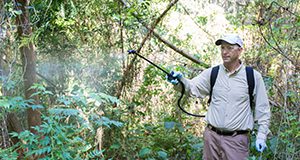Brazilian peppertree is encroaching upon nearly all terrestrial ecosystems in central and south Florida. This 5-page document discusses the plant's habitat, identification, characteristics, and biology as well as control methods. Written by K. T. Gioeli, S. F. Enloe, C. R. Minteer, and K. A. Langeland, and published by the UF/IFAS Agronomy Department, revised November 2018.
http://edis.ifas.ufl.edu/aa219
Tag: S. F. Enloe
Efficacy of Herbicide Active Ingredients Against Aquatic Weeds
Weed control is often a critical component of aquatic vegetation management in Florida waters. While physical, mechanical, and biological controls are utilized where they are feasible, herbicides are the primary tool used to control many troublesome species. This document answers some common questions and provides efficacy information for all herbicide active ingredients labeled for aquatic use in Florida. Written by S. F. Enloe, M. D. Netherland, W. Haller, and K. Langeland, and published by the UF/IFAS Agronomy Department, revised February 2018.
http://edis.ifas.ufl.edu/ag262
Herbicides to Kill Invasive Trees in Home Landscapes and Surrounding Natural Areas
Several plant species that are invasive in natural areas of public lands also occur on private property. Invasive plants on private property that thrive within both landscaped and surrounding natural areas can serve as a source of infestation to other natural areas. Therefore, property owners are encouraged to remove invasive plant species from both areas. This 5-page fact sheet is a major revision that discusses different herbicides, hand-pulling, stump grinding, foliar herbicide application, cut stump herbicide application, basal bark herbicide application, hack-and-squirt, frill, or girdle herbicide application, licenses and training, and control of specific invasive plants. Written by K. A. Langeland and S. F. Enloe, and published by the UF Department of Agronomy, revised May 2016.
http://edis.ifas.ufl.edu/ag259


